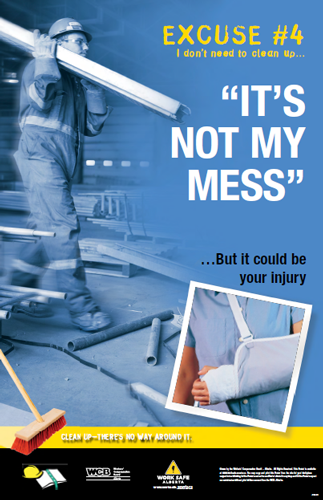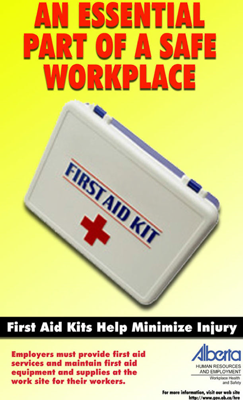Guide to Career and Technology Studies (CTS)
The Importance of a Health and Safety Culture to Everyday Life
It is important that students develop their own personal health and safety culture that will follow them beyond the school setting. These health and safety skills should transfer naturally into other aspects of the student’s life.
Example: Health and Safety Empowerment for Students
Students develop an awareness of safety and safety-related issues on the job, at home, and in the school setting. Students become knowledgeable and informed about workplace safety and safety legislation and know where to seek information, advice, and answers. Safety is a culture that all organizations and businesses work to facilitate. After learning the content in HCS3000, for example, students express that they feel empowered or more in control of their work environment. Students are now able to analyze an unsafe work situation they might see at school or at home and recommend a safe, practical solution or alternative practice.

© 2011 Government of Alberta. Alberta Labour.
Work Safe Alberta http://work.alberta.ca/occupational-health-safety/ohs-posters.html
Example: Health and Safety Committee
In the workplace, employees are encouraged to become part of the health and safety committee. At a minimum, any health and safety concerns are brought to the committee for action. Students realize the benefits to organizing a school health and safety committee. Regular meetings are scheduled and representation is from across all subject areas. Health and safety concern forms could be made available to individuals either through a committee member or from an online source. Incorporating health and safety policies and responsibilities through the student voice establishes a culture of health and safety that transcends across all stakeholders in the building.
Example: Reinforcing WHMIS and SDS
WHMIS is designed to reduce the risk from hazardous products used in the workplace. WHMIS is enforced by both federal and provincial legislation. Students complete WHMIS training in both their instructional areas and any off-campus placement. Employers need to ensure the health and safety of any workers who may be exposed to WHMIS-controlled products. Students use information from WHMIS training to ensure that materials are safely used and stored in the classroom and on the worksite. For example, paint used in construction or for a project in agriculture will need a Safety Data Sheet (SDS) if it is to be stored outside the original container.
Example: Recognizing the Hazards
Students viewing the scenarios presented at Work Safe Alberta’s bloodylucky.ca website reflect upon relevant examples of incidents that can occur to student workers. Titles include the following:
- At the Store
- At the Deli
- At the Restaurant
- At the Gas Station
- At the Café
- At the Lumberyard
The most common questions students investigate are “What health and safety procedures were not followed?” and “How could this incident have been prevented?” Students use the information learned in these scenarios to review hazard controls (i.e., engineering controls, administrative controls, and personal protective equipment) in each of their own instructional areas and throughout the school.

© 2011 Government of Alberta. Alberta Labour. Work Safe Alberta http://work.alberta.ca/occupational-health-safety/ohs-posters.html
Example: Good Housekeeping Works!
Slips, trips, and falls are common workplace hazards. Keeping the workplace free of these hazards is very important. When students get to class, they should always check out the room from the entry. Is the class cluttered? Is there debris on the floor? Are there tools, equipment, and materials lying around? Have extension cords been returned to their storage location? Is there easy access in and out of the room? Students work together to keep the room safe and healthy.

© 2009 Workers’ Compensation Board
http://www.wcb.ab.ca/employers/safety_posters.asp
http://work.alberta.ca/occupational-health-safety/ohs-posters.html
Example: Emergency Response
Close to the entrance of the room or lab, students should be able to find the necessary first aid supplies and the evacuation route to be used in the event of an emergency. Students should know who to contact for emergency first aid and should easily find the location of the first aid kit, the eyewash station, and the fire blanket. Taking care of each other through regular emergency practice and updates serves to keep students informed of the emergency response procedures that contribute to the culture of health and safety in the instructional area and the building.

© 2011 Government of Alberta.
Alberta Labour. Work Safe Alberta
http://work.alberta.ca/occupational-health-safety/ohs-posters.html
Example: Recognizing My Rights
Students who have been in an off-campus placement realize that they have rights. There is a partnership with their employer, the other employees on the worksite, and themselves. They have the right to know about any hazards at work and how to protect themselves, to participate in finding and resolving any health and safety concerns, and to refuse any task which they believe is dangerous or they are not trained to complete. With that right, however, comes the responsibility to cooperate, to use safety equipment correctly, to wear the appropriate personal protective equipment, and to behave in a safe and responsible way. This behaviour becomes part of the safety culture—everyone looks out for the health and safety of all others on the worksite or in the school.